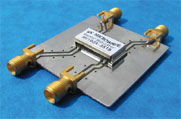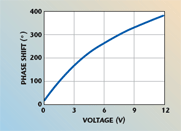
SV Microwave has introduced a family of surface-mount vector modulators with monotonic phase and attenuation response. These devices offer design engineers the benefits of modulating the phase and amplitude by applying a variable voltage and maintaining an always-increasing response of these parameters. In addition, these vector modulators offer minimum amplitude ripple and linear phase balance in their frequency ranges.
The new family of vector modulators is available with center frequencies in the 800 MHz to 2.5 GHz frequency range. Models are offered with 360° of phase shift and 35 dB of attenuation. In addition, the third-order intercept point (IP3) performance is exceptional with a guaranteed minimum of 40 dBm.

By utilizing state-of-the-art engineering techniques and Lean Six Sigma manufacturing practices, SV Microwave is able to provide vector modulators with outstanding performance at a competitive price. This product can also be supplied as RoHS compliant (lead-free), if requested.
The Vector Modulator Principle
The functional principle of vector modulators occurs when the input signal is divided into at least two signals and a phase difference is produced between these signals. Internal variable attenuators process these signals and a power combiner is added to obtain a phase-dependent vector sum.
There are two voltage-controlled bias signals required to control the phase and amplitude of the vector modulator. In these monotonic vector modulators, the amplitude and phase have a direct relationship with an increase in the control voltage. In standard vector modulators, this feature may not be controlled and, at certain voltage levels, the amplitude or phase may not increase.

In many applications, where errors in modulation must be controlled, it is imperative that the phase and amplitude are increasing consistently. If the polarity changes with a voltage increase, this could have major effects in the logic of the system and it will make it very difficult for system designers to track and monitor modulating errors. Figure 1 shows the typical phase shift vs. control voltage performance of a model MV152A-77ER7 vector modulator.
In addition to the monotonic response, these vector modulators have excellent phase and amplitude variation as well as low insertion loss. Table 1 summarizes some of the key features of these devices.
Vector Modulator Applications
Vector modulators are used in many applications, both military and commercial. They are typically used in radars, adaptive antenna combining, measurement, feed-forward amplifier systems and phased-array active architectures. The monotonic vector modulators are ideal for signal processing applications and very cost-effective solutions for commercial wireless networks.
SV Microwave Inc.,
an Amphenol company,
West Palm Beach, FL (561) 840-1800,
www.svmicrowave.com.
RS No. 302
